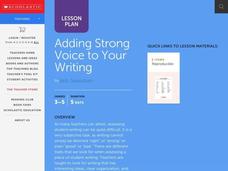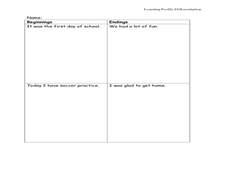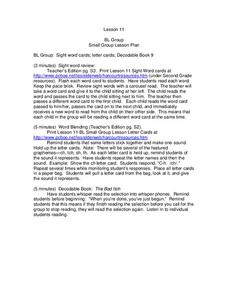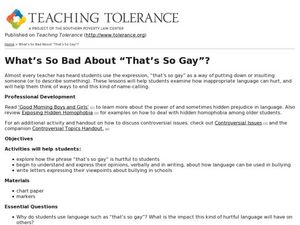Curated OER
Bad Case of the Stripes Lesson Plan
Students listen to the story Bad Case of the Stripes. In this respect lesson, students listen to the story and discuss bullying and how to respect others. They draw a picture of themselves covered in what they like to do.
Alabama Learning Exchange
Good Litter, Bad Litter
Which ones can be thrown on the ground? Discover the difference between natural litter and unhealthy trash, helping scholars by using several examples. Use the information here to give them a basic background, but also encourage prior...
Curated OER
Good Book, Bad Book: Lesson 2
An interesting way to incorporate pop culture and the elements that make a book good. Kids watch a clip from MTV Cribs, they discuss how good or bad books are similar to good or bad homes. They are all different and not everybody will...
Curated OER
Good Day/Bad Day
Students read the book Alexander and the Terrible, Horrible, No Good, Very Bad Day and discuss a bad day that they have had. In this bad day lesson plan, students compare their bad day with the story.
Curated OER
What's So Bad or Good About Conflict?
Learners of all ages discuss how conflict can be negative and positive. First, they create a class bulletin board about conflict, and provide their thoughts and connotations surrounding the word. In a class discussion, they ask questions...
Curated OER
Through the Eyes of the Big Bad Wolf
Imagine how the wolf would tell the tale of Little Red Riding Hood or The Three Little Pigs. Young writers re-imagine classic tales by adopting the point of view of another character in the story. After reading models like The True Story...
California Department of Education
My Best Resume
For employers and recruiters, the first step in their quest to find good candidates is the paper screening process. They look at a candidate's application and resume and push forward the files of those who meet their requirements. Thus...
EngageNY
Finding Relevant Information and Asking Research Questions: The Benefits of Video Games
Video games may not be so bad after all. As scholars read the text "The Many Benefits, for Kids, of Playing Video Games," they summarize the gist in their researchers' notebooks. Next, pupils draft supporting research questions based on...
Curated OER
How to Avoid Having a Bad Day
Second graders explore cause and effect. They read Alexander and the Terrible, Horrible, No Good, Very Bad Day. They discuss their own experiences with bad days. Students identify the causes and effects in the book. They write a letter...
Curated OER
Piggy Tale Election
Second graders investigate democracy by reading The Three Little Pigs. In this government activity, 2nd graders discover ways laws are changed or enacted by holding their own election in class. Students compare the Big Bad...
Curated OER
Adding Strong Voice to Your Writing
Identify examples of strong voice in popular picture books. Young authors add voice to their writing and revise their own writing. In addition, they share their writing with their peers.
Curated OER
Who's Afraid of the Big, Bad Wolf?
Students compare wolves' behaviors to those of the human race. In this wolf activity students write a story that will show that wolves are either good or evil.
Curated OER
Harmony and Expression in Writing Form
How do you write an interesting beginning, middle, and end of a story? With this lesson, young writers look to other stories as examples. Then, they use some of the attached graphic organizers to help them create their own story. Note:...
Curated OER
A Nice Story
Explore word choice in writing. Your class listens to a short story entitled "A Nice Day" (included) and discusses how the story could be improved. Pupils replace the word nice throughout the story with various synonyms, then reread the...
Global Oneness Project
The Man and the Wolf
Human attitudes toward the big bad wolf come into focus in a photo essay that asks viewers to consider their own feelings about the endangered species.
Curated OER
What Makes Jokes Funny?
Explore how language is used for comic effect. Middle schoolers determine which of the three formulas for jokes (double meanings, unexpected outcome, humorous mental image) make each of 18 classic, corny examples funny. They complete a...
Wisconsin Historical Society
Civil Disobedience
When is civil disobedience acceptable? Class members read examples of Jim Crow laws, an excerpt from Dr. Martin Luther King's "Letter from a Birmingham Jail," and a newspaper article and then consider the factors that make a law just or...
Curated OER
Who's Afraid of the Big, Bad Wolf?
Students, at the advanced beginner to low intermediate ESL levels, demonstrate comprehension of the play or story, "Little Red Riding Hood." They construct interviews based on knowledge of the characters in the play Little Red Riding Hood.
Curated OER
My Writing Portfolio
Emerging writers create a portfolio showcasing various writing formats. They discuss Alexander and the Terrible, Horrible, No Good, Very Bad Day. They observe the key features of picture books and then create their own book to add...
Curated OER
Connotation in Propaganda
High schoolers assess persuasive techniques in propaganda. They identify and critique rhetorical devices in primary source documents (sources are not specified, but links to sites that contain various documents are included). Groups make...
Curated OER
Lesson 11 BL Group
Three different groups work simultaneously in this lesson plan. One group works on sight word review by holding up common words on flashcards and passing them around in a circle. Another group reviews word blending by pulling graphemes...
Curated OER
How to Research and Write an Essay
Research and write a 500-word essay. Pupils research a topic and write an essay based on their research. They use the given directions and examples to help them research, organize, format, and write their essay. There's a short chart...
Curated OER
Lesson Plan 12: Writing With All Your Senses
What does an ice cream sundae sound like? Challenge young writers to move beyond visual descriptions and craft details that appeal to all five senses. The examples provided by the script in this resource show pupils how to create rich...
Curated OER
What’s So Bad About “That’s So Gay”?
Students explore the concept of inappropriate language. In this prejudice in language instructional activity, students examine how the phrase "That's so gay" is language that hurts others.
Other popular searches
- Bad Grammar Examples
- Examples of Bad Citizenship
- Examples of Bad Characters
- Examples of Bad Lesson Plans

























